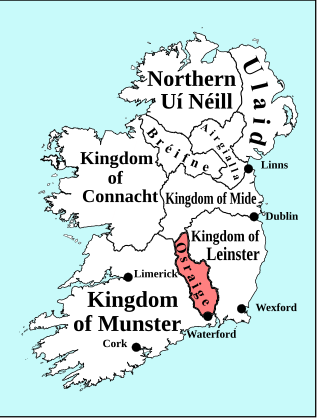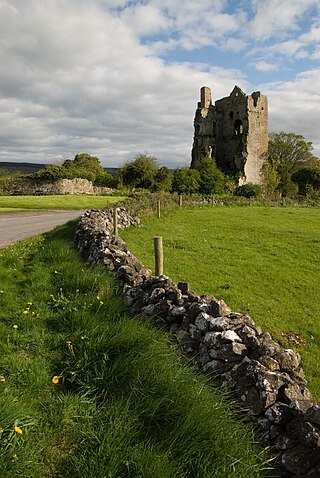
The kings of Osraige reigned over the medieval Irish kingdom of Osraige from the first or second century AD until the late twelfth century. Osraige was a semi-provincial kingdom in south-east Ireland which disappeared following the Norman Invasion of Ireland. A number of important royal Ossorian genealogies are preserved, particularly MS Rawlinson B502, which traces the medieval Mac Giolla Phádraig dynasty back through Óengus Osrithe, who supposedly flourished in the first or second century. and one in the Book of Leinster. Recent analysis of ninth and tenth century regnal succession in Osraige has suggested that in peaceful times, kingship passed primarily from eldest to youngest brother, before crossing generations and passing to sons and nephews.

Osraige or Osraighe, Osraí, anglicized as Ossory, was a medieval Irish kingdom comprising what is now County Kilkenny and western County Laois, corresponding to the Diocese of Ossory. The home of the Osraige people, it existed from around the first century until the Norman invasion of Ireland in the 12th century. It was ruled by the Dál Birn dynasty, whose medieval descendants assumed the surname Mac Giolla Phádraig.

Johnstown, historically known as Coorthafooka, is a small town in County Kilkenny, Ireland. Bypassed in December 2008 by the M8, the town lies at the junction of the R639, the R502 and the R435 regional roads. It is the home of the Fenians GAA hurling club. Situated 121 kilometres (75 mi) from Dublin and 131 kilometres (81 mi) from Cork, it lies in the agricultural heartland of the southeast.
Brian Mac Giolla Phádraig was an Irish poet and priest. He is not to be confused with any of the Barons of Upper Ossory, his relations, several of whom bore the same name in Irish.

The history of Kilkenny began with an early sixth-century ecclesiastical foundation, this relates to a church built in honour of St. Canice, now St. Canice's Cathedral and was a major monastic centre from at least the eighth century. The Annals of the Four Masters recorded the first reference Cill Chainnigh in 1085. Prehistoric activity has been recorded suggesting intermittent settlement activity in the area in the Mesolithic and Bronze Age. Information on the history of Kilkenny can be found from newspapers, photographs, letters, drawings, manuscripts and archaeology. Kilkenny is documented in manuscripts from the 13th century onwards and one of the most important of these is Liber Primus Kilkenniensis.

Galmoy is a barony in the north western part of County Kilkenny, Ireland. It is one of 12 baronies in County Kilkenny. The size of the barony is 162.7 square kilometres (62.8 sq mi). There are 12 civil parishes in Galmoy. While it is named after the village of Galmoy, today the chief town of the barony is Urlingford. Galmoy barony lies at the north-western corner of the county between Fassadinin to the east, and Crannagh to the south. It is surrounded on two sides by counties Tipperary to the west and Laois to the north. The M8 Dublin/Cork motorway bisects the barony. It is situated 121 kilometres (75 mi) from Dublin city and 131 kilometres (81 mi) from Cork city. Galmoy is currently administered by Kilkenny County Council. The barony was part of in the historic kingdom of Osraige (Ossory).
Barnaby Fitzpatrick (c.1478–1575) was the last person to have claim to the kingship of Osraige; forfeiting his ancestral title in favour of being created the first Lord Baron Upper Ossory by King Henry VIII of England, by patent dated 11 June 1541, as part of the King's policy of Surrender and regrant. Barnaby Fitzpatrick was subsequently knighted on 1 July 1543.

Upper Ossory was an administrative barony in the south and west of Queen's County in Ireland. In late Gaelic Ireland it was the túath of the Mac Giolla Phádraig (Fitzpatrick) family and a surviving remnant of the once larger kingdom of Ossory. The northernmost part of the Diocese of Ossory and medieval County Kilkenny, it was transferred to the newly created Queen's County, now known as County Laois, in 1600. In the 1840s its three component cantreds, Clarmallagh, Clandonagh, and Upperwoods, were promoted to barony status, thereby superseding Upper Ossory.

Cullahill Castle was the principal stronghold of the MacGillapatricks of Upper Ossory built around 1425 and destroyed around 1650. Cullahill Castle takes its name from an ancient forest that covered Cullahill Mountain and extended down to Cullahill village.

Mac Giolla Phádraig is a native Irish dynastic surname which translates into English as "Son of the Devotee of (St.) Patrick". In the medieval period, the Mac Giolla Phádraigs were hereditary kings of Osraige; today, the anglicised version of the name is commonly "Fitzpatrick".
Óengus Osrithe son of Criomthann Mór and his wife Cindnit, daughter of Dáire mac Degad and Morand, was the semi-legendary first king and eponymous ancestor of the Osraige people of Ireland. His supposed floruit lies in the late first or early second century AD.
Florence Fitzpatrick, 3rd Baron Upper Ossory, was the third son of Barnaby Fitzpatrick, 1st Baron Upper Ossory and his wife Margaret Butler, and inherited the title upon the death of his older brother Barnaby Fitzpatrick, 2nd Baron Upper Ossory in 1581. He married Catherine O'More, daughter of Patrick O'More of Abbeyleix, and had six children, including his son Teige, who succeeded as 4th Baron, and Joan who married John Butler of Dunboyne, by whom she was the mother of Edmond Butler, 3rd/13th Baron Dunboyne.

Teige Fitzpatrick, 4th Baron Upper Ossory (d. December 1627) was the son and heir of Florence Fitzpatrick, 3rd Baron Upper Ossory, by his wife Catherine O'More. He married Joan Butler, the daughter of Sir Edmund Butler of Cloughgrenan.
Barnaby Fitzpatrick, 5th Baron Upper Ossory was the son and heir of Teige Fitzpatrick, 4th Baron Upper Ossory.
Barnaby Fitzpatrick, 6th Baron Upper Ossory, was the heir and successor of Barnaby Fitzpatrick, 5th Baron Upper Ossory. The eldest son of Barnaby Fitzpatrick by his wife Margaret Butler, he took his seat in Parliament on 16 March 1639. He married Catherine Everard, daughter of Sir Edward Everard, and his heir was his eldest son, Barnaby.
Barnaby Fitzpatrick, 7th Baron Upper Ossory, was the eldest son, heir and successor of Barnaby Fitzpatrick, 6th Baron Upper Ossory by his wife Catherine Everard.
Riagan mac Dúnlainge was king of Osraige from 888 to 894 AD.
Diarmait mac Cerbaill was a king of Osraige from 894 to 905, and again from 908 to 928 AD.

The Monastery of Ennisnag was an early Irish Christian monastery, and later a medieval prebendal church, located at Ennisnag, in County Kilkenny, Ireland. The medieval monastery and church are no longer extant. From the ruins, St Peter's church, of Protestant denomination, was established in the early 19th century.
Gilla Pátraic mac Donnchada was king of Osraige and the progenitor from whom all Mac Giolla Phádraigs (Fitzpatricks) of Ossory took their hereditary surname. Gilla Pátraic succeeded his father Donnchad mac Cellaig in 976. Donnchad mac Cellaig was the son of Cellach mac Cerbaill, king of Osraige and his wife, Echrad ingen Matudán. After a reign of 21 years, Gilla Pátraic was slain by Donnabhan, king of the Danes of Waterford, and Domhnall, king of the Desies. By his wife, Maelmuire, he had five sons: (1) Donnchad mac Gilla Pátraic, king of Osraige and king of Leinster; (2) Dunghal ; (3) Tadhg ; (4) Diarmaid ; and, (5) Muircheartach.













